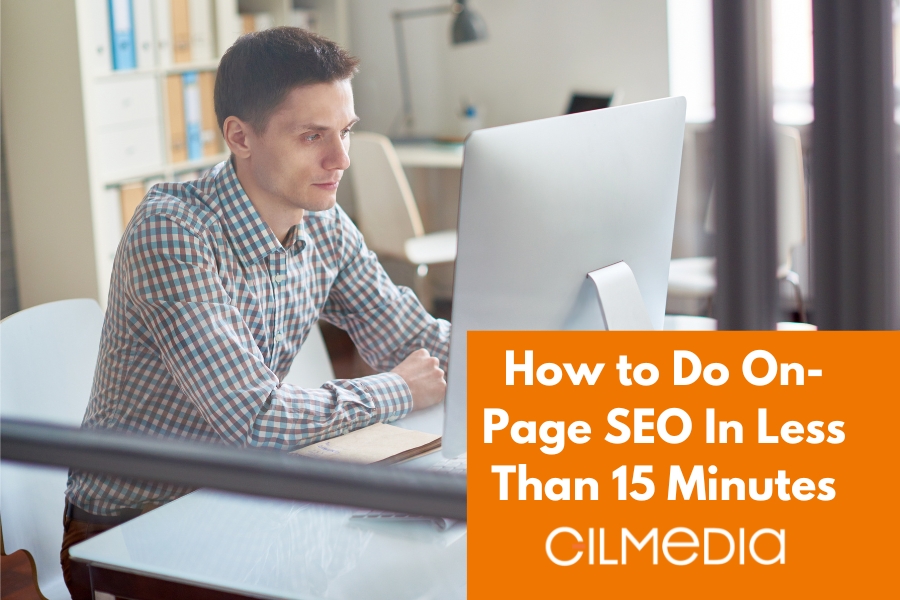At this point, it’s likely clear to most people that search engine optimization (SEO) is more competitive today than ever before. The real key to success in the world of search engine optimization is mastering on-page SEO in your web development strategies. That’s why we’ve put together this quick guide. Below you’ll uncover inside information that will help you polish up your on-page SEO in less than 15 minutes. Create a little checklist of these tips and tricks for each piece of content you create to hit the ground running with more effective and more strategic SEO campaigns than your competitors.
The Importance of On-Page SEO Optimization

Before we get into the details of how to boost your search engine optimization results with on-page strategies it’s crucial to highlight the value of on-page SEO, to begin with.
There are a lot of wrong SEO operations out there that will tell you off-page work is all that matters, but the research and evidence straight from the folks at Google will tell you that on-page SEO is just as important (if not even more important) when it comes to shooting up the ranks.
While Google has smartened up their algorithm over the decades, search engine spiders still rely on keywords, title tags, heading tags, and the like to figure out precisely what your content is all about and where it belongs when it comes to search results. On-page efforts to optimize are just as vital today in 2020 (and beyond) as they were in the early days of the web when Google was a bit more Wild West.
Optimizing Your First 100 Words
Straight out of the gate you want to be sure that you are heavily optimizing the first 100 to 150 words of your content, particularly making sure to include your main keyword in this initial chunk of text. Google crawlers are always going to try and streamline their crawl process and that means they will focus on bite-size chunks of content rather than crunching every letter on your page. The early section of your content serves as your introduction to your visitors and Google crawlers, and any SEO service will tell you that you want to begin your content with your most important keyword in this first block of text.
Knock Out Smart H1 Tags
You also want to make sure that your content title, the most relevant title for your page – has the most prominent heading tag attached, the H1 tag. Many marketers and successful entrepreneurs forget about how valuable the H1 tag is, but that’s just not a mistake that you can afford to make. The H1 tag outlines the structure of your site for Google (and any other major search engine out there) and is always going to be a big piece of the puzzle behind your success or your failure when it comes to SEO today.
Make sure you use H1 content that has your most impactful keyword inserted into it if possible but don’t write for search engine spiders exclusively. You’ll get punished by the folks at Google for that approach – keep your content created for human eyeballs above all else.
Subheads ALL Get H2 Tags
It’s also a good idea to make sure that any of your follow-on subheads include H2 tags but that at least one of them has your primary keyword included, too. Without that primary keyword, you’re losing out on a lot of “link juice” you could easily generate otherwise, the sort of link juice that can help your site skyrocket up the ranks when done judiciously (as opposed to literally spreading it all over all of your tags).).
Check Your Frequencies
Keeping a close eye on keyword frequencies is critically important, as you should never overstuff your content. Nothing is going to send you to the back of the Google sandbox faster than keyword frequencies that are through the roof and it’s always important to have your keywords sprinkled throughout your content intelligently. Also, make sure that you are using variations of your main keyword a handful of times, but try to limit yourself to using your main keyword maybe 10 times (or less) on every page of content.

External Links are a Big Piece of the On-Page Puzzle
External links that go from your page to other domains are seen as a huge credibility booster by the folks at Google. We are talking about educational sites, government sites, reputable organizations, etc. – providing you with the biggest bump in your credibility with this on-page approach. Google sees you as a hub for useful and high-quality information when you have a couple of external links pointing out words, and then as soon as you’re off-page work starts bringing backlinks into your content you’ll be able to light a match under your search engine climb.
Tip the Scales on Your Title Tag
You’ll never go wrong front-loading your title tag with your most valuable keyword, especially since your title tag basically “declares” what your page is all about behind the scenes – particularly to search engine spiders and the Google algorithm. Make sure that you aren’t stuffing all of your title tags with the same keyword across your site. Give each title tag its unique keyword and unique tag from one another, and you’ll be good to go!
Within about 15 minutes or so, you are going to be able to have your site perfectly optimized (from an on-page perspective, anyway).
If you do want to take things to the next level, don’t be shy about hiring professional SEO Toronto agencies and organizations with a proven track record of success. They can take you to the next level, pushing a flood of targeted traffic to your site, in the blink of an eye!


